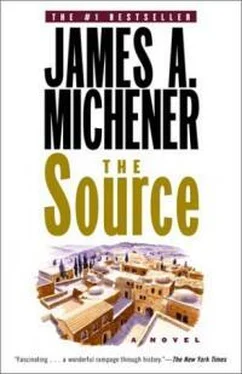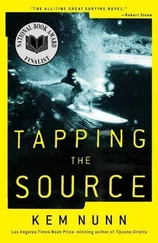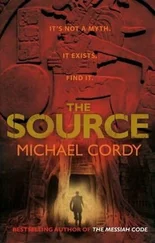Thus Makor, for the fourth time in its history, was for the moment stripped of Jews. Sennacherib had destroyed them. Nebuchadrezzar had led them into captivity and Vespasian into slavery, but each time stragglers had returned to rebuild petty settlements. Now the Byzantine expulsion threatened permanent results, for it had involved religious motivations, and these were apt to be longer-lasting.
When the final Jew was gone, when Mark had disappeared into the Syrian desert from which he would emerge years later a theologian of great power, John the stonecutter took charge of leveling the synagogue to make way for the church, and with each rock he shifted, an ache moved in his heart. The little animals he had carved with such love had been smashed by the rioters; the decorated lintels were knocked down; the marching swastikas were gone; the pillars were upended; and his poetic floor had been gouged out. The only sensible thing to do was to erase all memory of the place, setting aside such stones and pillars as might be used again. Accordingly, the hulking stonecutter directed his workmen to salvage the unbroken pillars and to make bands of iron to restore those that had been fractured. He organized teams of women to gather in baskets the mosaic cubes and to clean them for reuse, but when the new basilica was completed, usurping the site of the synagogue, and when the time came for designing the mosaic floor, John found that even though he had at his disposal the same colored stones as before, he was unable to re-create those joyous memories of his youth.
LEVEL
VI
A Day in the Life of a Desert Rider
Ornamental work carved in white limestone to decorate the Chapel of Omar set aside for Muslim worshipers in the Basilica of St. Mary Magdalene at Makor. Installed October 18, 644 C.E. (A.H. 22). Defaced with a panel of crosses by Crusaders from Germany, May 24, 1099 C.E. Deposited on the afternoon of March 26, 1291, during the siege of the town .
Jews had been living in Makor for two thousand, eight hundred and thirty-seven years before the first Arabs settled there, but the soldier who brought the Muslims to this town was a singular person and his arrival was an affair of moment.
In the city of Tabariyyah, on the cold rainy morning of November 22, 635, two different squadrons of Arab raiders saddled their camels in the pre-dawn light that sifted down upon a crowded caravanserai standing beside the lake. They were about to participate in a meaningful experiment whose results would go far to determine the nature of Islam in Palestine and Africa. The men of the first squadron, reflecting from their white robes the lights of a campfire, were agitated and noisy, moving this way and that with curved swords gleaming as they prepared to embark upon a dangerous mission. They were led by a small, wiry Arab of marked energy, the captain Abu Zeid, whose fiery commands, whispered like the utterances of a serpent, bespoke the violence with which he had led his desert troops in their conquest of rich Byzantine cities. As he strode among his men, testing their saddles and their swords, his face was sometimes illumined by red flames from the fire and he seemed an avenging demon hovering at the edge of Tabariyyah, ready to strike with great fury. Finally he could control his impatience no longer, and without awaiting official orders from the silent headquarters building, sprang into the saddle of his gray mare, kicked her flanks vigorously and led his troops through the gates and into the darkness, crying, “To Safat! Allah will lead us!” Stragglers lounging by the camp cheered as the troops rode forth, while warriors who watched them go said with practiced judgment, “By nightfall Safat will be Arab.” There might be no residents surviving in the city, and houses might be roofless, but they would be Arab.
When that first violent squadron was gone another became gradually visible in the dark shadows encompassing the caravanserai: these men were not mounted, nor were they nervous. They moved with quiet determination among their camels, tying down burdens and tightening saddle straps as if they were about to depart on a trading expedition where all things were known except the price of cloth. They were Arabs, all of them, and like the first group had proved themselves in the capture of Damascus and the occupation of Tabariyyah. They constituted one of the finest segments of the Arab army, and whereas the riotous troops of Abu Zeid had been thrown against Safat to kill and burn, this second contingent had been held in reserve for the more significant part of the test.
Their leader stood by a pillar of the caravanserai, a tall, slim man wearing a gray headdress that reached to his waist and a multicolored robe composed of many strips of cloth sewn together. He wore heavy sandals and a wide belt of woven goat’s hair which supported a leather loop from which hung a medium-sized sword. He was a man of dark countenance, in his mid-thirties, and he said little. Keeping to the shadows he observed his men as they checked their battle equipment, then directed one to find out whether all animals had been watered. He studied with approval the forty-odd horses that stood easily in the midst of the caravanserai, excellent beasts which had proved their mettle at Damascus. They wore no saddles, but three large camels stood nearby loaded with their equipment, including spare saddles, and the tall man in the many-colored robe moved slowly, like a merchant on an ordinary day, to inspect these camels, assuring himself that his own red-studded saddle was included in the luggage. He then returned to his pillar, from which he studied the eastern sky, where above the Sea of Tabariyyah the stars were fading and the light of sunrise was beginning to show.
He was Abd Umar, and his first name signified that he had been born a slave: his father had been some unknown desert warrior, his mother a black Abyssinian slave captured on some raid to the south, but he had never known either of his parents. He had grown up in the Arabian city of Yathrib and had spent his early years leading camel caravans from that trading center over the seven hundred miles to Damascus and back. He spoke Arabic and Greek, and when the Arabs burst out of the desert with a new message for the world he had found a place among the armies and a position of responsibility among the chiefs of the tribes. In what other nation could a half-Negro slave win a post of such honor? For the Prophet had said that when God created men he lifted dust from all parts of the earth, and some was black and some red and some white, but all men were made of that dust and all were therefore brothers.
It was this slave who had been picked for the day’s important mission. The Arabs hoped that while Abu Zeid and his ruffians were subduing Safat in the hills, the disciplined troops of Abd Umar might succeed in capturing Makor without much killing, for if that town could be occupied peacefully, the crucial seaport of Ptolemais, which the Arabs knew by the ancient name of Akka, might surrender without a siege, and retention of this port was necessary if places like Tyre, Cyprus and mighty Egypt were to be invaded. It was with knowledge of these strategies that the slave now walked among his men, whispering, “It’s almost dawn.”
Silently, as if they too appreciated the gravity of the day, his men mounted their camels, keeping the forty riderless horses under control: those handsome brown-flanked beasts would be used by a picked group for the final assault on Makor and must be kept rested during the initial part of the expedition. Now the warriors atop the camels became visible in the gray light which spread over Tabariyyah, bringing the hills into relief: they were hardened fighters who had met the best mercenaries that Byzantium could throw against them. Many wore short beards but most were clean-shaven like their leader. They wore robes of every hue and dimension; when their clothes were of a dun color the men seemed to merge into the bodies of their camels, but when the robes were alternate lengths of purple, red, yellow, brown, green and blue, the Arabs were like bright birds that had flown in from the desert, seeking the valleys of Palestine. In eight years this resolute body of men had not known defeat and they were now quietly determined that this day would see both their victories and their faith extended. Waiting quietly for Abd Umar to mount and lead them forth, the Arabs relaxed on their camels as if they were sleeping centaurs, while their horses stood with equal patience.
Читать дальше








![Джеймс Купер - Пионеры, или У истоков Саскуиханны [The Pioneers, or The sources of the Susquehannah]](/books/395797/dzhejms-kuper-pionery-ili-u-istokov-saskuihanny-t-thumb.webp)

